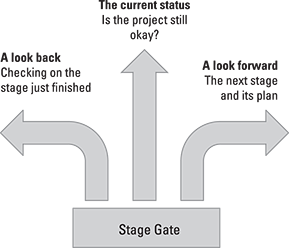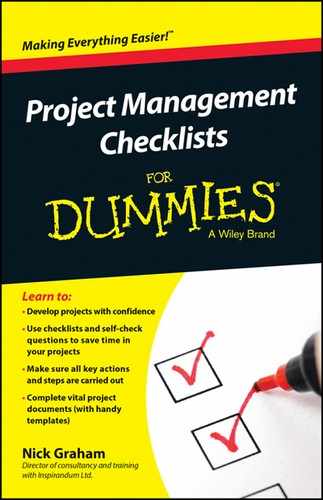Chapter 14
Conducting a Stage Gate
In This Chapter
![]() What a Stage Gate is
What a Stage Gate is
![]() The importance of Stage Gates in effective project governance
The importance of Stage Gates in effective project governance
![]() Checklists for Stage Gate meetings
Checklists for Stage Gate meetings
A Stage Gate is a meeting of the Project Steering Group members with the Project Manager at the end of a Delivery Stage. Typically the meeting will be between 45 and 90 minutes long, but erring towards the 45 minutes. The meeting is to check back on the stage just finished, a check on the current state of the whole project and then a look forward to the next stage and check its plan. Figure 14-1 shows the three views of the Stage Gate.

Figure 14-1: The three views at a Stage Gate.
Stage Gates are important, they really are. But along with all other responsibilities of Steering Groups (sometimes known as Project Boards) this has to be one of the worst managed areas in projects. It would be a great kindness to say that Stage Gates are generally done badly because the truth is that they aren’t often done at all – except superficially to make things look good.
The fact is that the work of the Project Steering Group (PSG) is absolutely vital, just like the work of senior managers in a department is absolutely vital if that department is to succeed. It’s the PSG that has overall responsibility for project governance – that the project is set up properly and then is being run well. A key element of this is the Stage Gates which are extremely important, though not necessarily difficult, control points in the project.
If you’re reading this as a PSG member that’s great because clearly you want to get the Stage Gates right rather than play project games. The next three checklists are to help you do exactly that.
The ‘Look Back’ Checklist
Here’s a list of things to help check on the Delivery Stage that’s just finished. You may do some of the checking in advance of the meeting or have checks done by Project Audit. If there has been an audit, you should review the findings before the Stage Gate, not during it.
- Stage Completion Report: Review the report provided by the Project Manager. You may have asked her to do this as a business presentation with notes of the details; that requirement will be set down in the Communications Plan. The review may take in at least some of the remaining points on this checklist.
- Product completion: Make sure that everything that the project has delivered everything it was supposed to have during the stage. Also check that any necessary acceptances or sign offshave been obtained.
- Quality: Check to ensure that the required quality was delivered and that all necessary tests and checks were performed.
- Timing and performance: Review the use of staff hours in comparison with the original plan, and also check team performance. If the teams performed better or worse than expected, ask questions to find out why and then consider action and implications for the rest of the project.
- Budgets: Review the spending for the stage and how close the final figure was to the planned amount. Also check on the use of the Change Budget and Risk Budget. If you’re not too clear about the different budgets then have a look at the side panel on the next page.
- Projections: Look to see whether the experience of the stage just finishing, together with any before that, has implications for the remainder of the project.
- Lessons: If useful things were learned in the stage (good stuff as well as bad stuff) that would be of immediate help to other projects, get the details from the Project Manager in order to forward them to others in the organisation.
The ‘Current State’ Checklist
This part of the Stage Gate is to assess the current state of the project and also to establish if authorising the next stage is actually the right thing to do. If the project is out of control or is no longer viable, the correct management decision is to stop the project, not let it roll on and so waste money and staff resources.
- Project Manager’s assessment: check out the Project Manager’s view on the project, both the positive and the negative.
- Business Case: Review the Business Case carefully and think about the implications of any changes. For example, the projection of benefits may have changed (in either direction) and that could affect the viability of the project.
- Scope: Check the Scope Statement to ensure that it remains both accurate and sensible. If any new requirements have emerged in the last stage, check that they’ve been recorded, together with the source, and that the Scope Statement or any other documents reflect them.
- The rest of the Charter: Review the rest of the Project Charter to be sure that it accurately reflects the current position of the project.
- PMP controls: Review the controls in the project as set down in the latest version of the Project Management Plan (PMP). Check things such as referrals to the PSG and progress reporting and ensure that they have been working satisfactorily. If there have been any problems, then make sure that the necessary adjustments have been made or make them now.
- PSG: Following on from checks on the overall controls, honestly review whether the PSG itself has functioned well in the last stage. If not, make changes.
- Roles: Review how well people have been functioning in the project roles. In other words, have you got the right people and are they doing their jobs well? If necessary, make changes – and that includes changes to the PSG roles.
- Risk: Review the overall project risk position as it is now, based on the Project Manager’s recent update of the Risk Log. Also check the risk management mechanisms to ensure that they’re working.
- Viability: Based on the knowledge you have gained from the previous items on this checklist, especially the Business Case, assess whether the project is still viable and should continue. If not, instruct the Project Manager to begin the work to close it down.
The ‘Look Forward’ Checklist
If the PSG has decided that the project should continue, you must now turn to the detailed plan that the Project Manager has compiled for the next stage. If you’re a PSG member then the Project Manager should have consulted you during the preparation of this plan so nothing in it should come as a surprise. However, you still need to be sure that you’re happy with it before you approve it and authorise work to begin on the next stage.
- Accuracy: Check that the Stage Plan is accurate and correctly reflects the Project Plan for this part of the project.
- Contingency: Make sure that there is sufficient contingency in the plan to cover things that will go wrong, because something surely will. The amount of contingency will partly reflect the degree of identified risk in the stage, but contingency is also needed for unforeseen problems.
Murphy’s Law: If it can go wrong, it will go wrong. O’Connor’s Corollary: Murphy was an optimist.
- Controls: Make sure that you are happy with the controls for this stage. The controls may be slightly different from the previous stage perhaps, for example, because this stage is higher risk.
- Quality: Check that there will be sufficient control over quality to ensure that the right level will be delivered. This check may be fast to do if the stage will continue with the controls used earlier in the project and they have already proved to be effective.
- Resource: Look at the resource allocation and check that the resource is available. This will mean the Project Supplier and Project User on the PSG confirming that the resource shown on the plan will be available.
- Funding: Confirm that the finance is available for the stage, and that includes the Change and Risk Budgets. Check that the budgets are sensible and reflect the work on the one hand, and the assessment of risk and likely change on the other.
- Realistic and achievable: Stand back from the plan and assess whether, overall, you are confident that the plan is realistic (such as the estimates for activity durations) and achievable.
PM’s Stage Gate Checklist
If you’re the Project Manager, you’ll be preparing information for the Stage Gate. Here’s a checklist to help you make sure that you’ve got everything ready in advance of the Stage Gate. A lot of the ground is covered in the Stage Completion Report but the checklist adds a few bits that you’ll need along with it.
- Stage Completion Report: Starting with the most obvious, you’ll need to provide copies of the report for the PSG members – and don’t forget one for yourself.
- Charter and PMP: Provide copies of the updated Project Charter and PMP (Project Management Plan) for the PSG members, with a copy of each for yourself too.
- Equipment: If you’re giving the report in the form of a business presentation, don’t forget to check out the kit beforehand to make sure that it’s in place and working, and be sure that you have the presentation slides loaded on the computer and ready to roll.
- Supporting information: Have information to hand to answer any questions of detail, including your source calculations for things like spending and team performance.
- Lessons: If lessons have been learned in the stage just finishing that will be of immediate use to other projects, have brief notes ready in a form that the PSG can pass on into the organisation.
- Notes for your points: If you want to mention any particular points about the running of the project, prepare a list of them with brief notes so you don’t forget to cover them.
- Next Stage Plan: Provide copies of the plan for the next stage for each of the PSG members, and again a copy for yourself so you don’t have the embarrassment of having to ask to look over someone’s shoulder at their copy if they ask a question on it.

 You’ll find a sample agenda for a Stage Gate meeting in Chapter
You’ll find a sample agenda for a Stage Gate meeting in Chapter  Don’t authorise the start of the next stage unless you are convinced that the plan for it is realistic and achievable. As a PSG member you’re responsible for the good governance of this project. If you sign a plan that you don’t think is achievable then you completely undermine the good governance that you’re supposed to be ensuring.
Don’t authorise the start of the next stage unless you are convinced that the plan for it is realistic and achievable. As a PSG member you’re responsible for the good governance of this project. If you sign a plan that you don’t think is achievable then you completely undermine the good governance that you’re supposed to be ensuring.